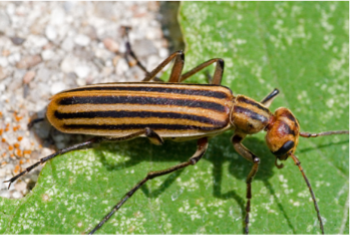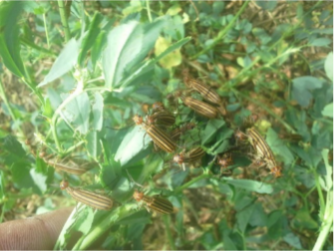Be on the Lookout for Blister Beetles in Alfalfa
I have received several reports of blister beetle activity in the past couple of weeks. This time of year, blister beetles can become a major consideration to alfalfa hay buyers and producers. In Oklahoma, adult beetles are active from mid-May to early fall. Striped blister beetles generally concentrate in higher numbers in June and July.
While several species commonly occur in Oklahoma, an estimated 75% of the total number of blister beetles occurring in Oklahoma alfalfa are striped blister beetles Epicauta occidentalis (Fig. 1).
Figure 1. Adult Striped Blister Beetle. Photo credit, BugGuide.
While all species contain Cantharidin, the striped blister beetle contains the most concentration of the toxin (5 mg/beetle) compared to other blister beetle species (0.5 mg/beetle). Cantharidin provides the beetles protection but may also affect livestock health when beetles are inadvertently incorporated into baled alfalfa during harvest. When livestock, particularly horses, are fed forage containing bodies or fragments of these insects, illness or death can result.
Because of their congregating (swarming) nature, remains of beetles killed during the alfalfa harvesting process can be concentrated in a few hay bales or small portions of bales (Fig. 2).
Figure 2. Blister Beetle Swarm. Photo Credit, Oklahoma State University Extension.
Cantharidin is a stable compound that retains its toxicity to livestock even when dried remains of the beetles are fed along with the forage. The number of blister beetles needed to cause harm, especially horses, can vary greatly depending on breed, size, and nutritional state. The lethal dose is estimated to be between 0.5 and 1.0 mg Cantharidin per kilogram (2.2 lbs) of body weight (UK Ext., 2023).
A few things for growers to consider for reducing beetle contamination are:
- Match cuttings and markets. Early-May and late-September harvests are before and after the major blister beetle season. Target these cuttings for horse buyers.
- Cut alfalfa in the bud stage; the presence of blooms is attractive to blister beetles and increases the likelihood of infestations.
- Utilize a short residual pyrethroid insecticide before harvest, but make sure the product has no/minimal waiting period before harvest. Target the market before spraying to be sure the premium from the buyer justifies application costs.
- Do not use a crimper when swathing alfalfa hay. Crimpers crush beetles into the hay and kill them. A simple cutter bar cuts very few insects and they fall to the ground. The live ones fly away as the hay wilts. This is also an effective method for grass meadows used for grazing.
- Blister beetles are attracted to flowers of many plants and weeds. Maintain weed control in border areas to prevent flowering and attracting beetles.
- Watch carefully when swathing, even large swarms can be overlooked by experienced operators.
- Try to eliminate or minimize tire traffic on cut or uncut hay. This will reduce crushing beetles into the hay swath. Remember, a dead beetle is just as toxic to a horse as a live one.
As there is no way to completely eliminate the possibility of blister beetles being in alfalfa, the prudent approach for management is to take all possible precautions to reduce the likelihood that they are present, particularly when marketing hay to horse owners.
Livestock owners buying alfalfa should know their supplier well and find out what precautions were taken to avoid blister beetles in hay. In addition, when feeding hay, monitor for any signs of insects.
Additional information on blister beetles in alfalfa can be obtained from OSU Extension Fact Sheet EPP-2072, Blister Beetles and Alfalfa.


